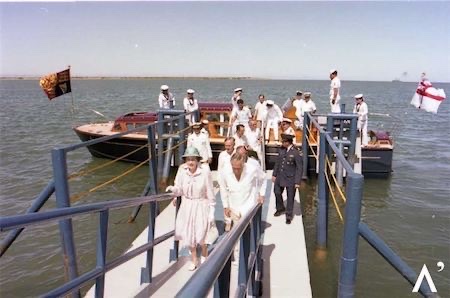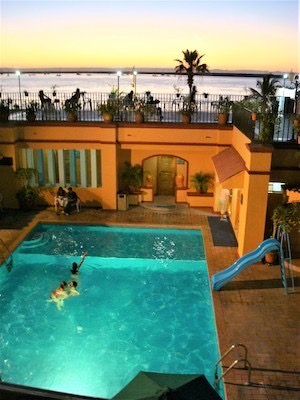 |  |
By Greg Niemann

It was pearls (perlas) that attracted Hernan Cortes to La Paz but he was unable to sustain his colony of Spanish settlers back in 1535. For the next 185 years, until a mission was established there in 1720, La Paz was visited only by temporary pearl-hunters.
La Paz was noted for its black pearls (actually a metallic gray) and the pearls were harvested for over 400 years. Until 1874 when diving suits were introduced, local Indians were often forced to free-dive to bring up the shells bearing the coveted pearls. In the late 1800s, the beautiful abalone shells themselves also began to be harvested and shipped.
One large pearl, a pear-shaped 400-grain “Pearl of La Paz” was gifted by the pearlers to the Queen of Spain.
By decree of May 11, 1861, La Paz, then with a population of about 800, was named a free port and, along with shipping pearls, was able to receive foreign goods.
In 1868 Russ Browne reported in his book “Explorations in Lower California” that “The pearl fishery has greatly declined for several years past; the oysters having become scarce in the waters of the best fishing grounds, either in consequence of storms or other disturbances.”
By 1941 the pearling industry petered out entirely as the pearl oyster which attracted Cortes and hundreds of others disappeared due to over-harvesting and disease.
In 1941 American Nobel Prize winning author John Steinbeck visited La Paz and based his book “The Pearl” on his experience.
Steinbeck became enamored with the town and reported in his book “Sea of Cortez,” “…There is the genuine fascination of the city of La Paz. Everyone in the area knows of the greatness of La Paz. You can get anything in the world there, they say. It is a huge place—not of course so monstrous as Guaymas or Mazatlan, but beautiful out of all comparison.…a cloud of delight hangs over the distant city from the time when it was the great pearl center of the world. The robes of the Spanish kings and the stoles of the bishops in Rome were stiff with the pearls from La Paz.”

It seems Steinbeck’s comment resonated with an interesting story. In August 1883, two divers working for La Paz pearling company owner Don Antonio Justa Ruffo Santacruz found a huge pearl. Ruffo named the gem Carmelaida, in honor of his two daughters, Carmen and Adelaida Ruffo. For many years, he kept the pearl on display.
At some point Don Antonio Ruffo showed the pearl to the U.K. Ambassador to Mexico, who offered to buy it and gift it to Britain's King Edward VII. Instead, Ruffo gifted the pearl to the King himself. They say the King was so impressed with the pearl he had one of the royal jewelers incorporate it into the Royal Crown.
The English jewelers who worked on it named it The Great Lemon (El Gran Limón). It is the same headgear that years later the King's granddaughter, Queen Elizabeth II, wore on official occasions.
The Queen was reportedly curious about the origins of El Gran Limón. On her second visit to Mexico in February of 1983 (the 100th anniversary of the huge gem’s discovery) she and her husband Prince Philip, while traveling aboard their yacht Britannia, made a stop at La Paz as an honored guest of Baja California Sur governor Alberto Andrés Alvarado. After this visit, she went whale watching in Guerrero Negro, before continuing on to Northern California.
The Pearl lives on
The Pearl of La Paz lives on, and not just in Steinbeck’s book title, nor as royal jewelry, but in the form of a hotel—and also for many decades, an historic mercantile company.
In 1860 the aforementioned pearler Don Antonio Ruffo Santacruz established La Perla de La Paz, also known as Casa Ruffo, as an important trading house and department store. It was the largest store on the Baja península and offered a wide variety of goods from a kilo of sugar to the finest fabrics and fragrances from around the world.
It also sold hardware tools necessary for the miners of El Triunfo and San Antonio. The grand old store was eventually listed as an Historical Heritage in 1986 by the Mexico’s National Institute of Anthropology.
The over-a-century La Perla de la Paz department store was still in existence through the 1990’s and I popped in for something every time I was in town. It was a wonderful big colonial store, with thick walls, broad concrete pillars, wide aisles, old yellowing linoleum floor, expansive shelving, and lots of merchandise, from furniture to food to clothing.

Unfortunately, in 2006 it suffered a fire that destroyed most of the building and today only the façade remains standing. The scaled-down department store moved to an adjoining building and the Ruffo family is still prominent in La Paz.
La Perla Hotel
By the mid-1930s there was no place in La Paz (the state capital and largest town) to accommodate anyone. Lodging for distinguished visitors had to be provided by local merchants and politicians.
This led to the government creating a semi-public fund to build a hotel. So the Hotel Perla de la Paz Corporation opened and shares were sold to the citizens. Most of the shares were bought by the Castro and Ruffo families. The Ruffos had early on sold their interest in the hotel but continued to operate their nearby store.
Once funded, by early 1940 construction on what was considered the first modern hotel in the State of Baja California Sur was underway. The legendary Hotel Perla, built in a simplified art nouveau style, opened in March 1940 with 25 comfortable guest rooms and a grand ballroom named “Salon Madre Perla” (The Mother Pearl Salon).
The inauguration ceremony was hosted by its founders: Col. Rafael Pedrejo (then Governor of Baja California Sur Territory), Juan Manuel Castro, Jorge Vonborstel, Miguel Cornejo, Salomon Tuchman, Arturo Canseco and 15 other associates.
Steinbeck was partially prophetic in his reaction: “On the water’s edge of La Paz a new hotel was going up, and it looked very expensive. Probably the airplanes will bring weekenders from Los Angeles before long, and the beautiful, poor bedraggled old town will bloom with a Floridian ugliness.”
Center for important events
Fishermen now fly in for weekends, but the ugliness projected by Steinbeck is for the most part still on hold. The Hotel Perla, which has graced the Malecon facing the bay for over 80 years, hosted most of the important events in the growing city for decades.
Following the 1941 attack on Pearl Harbor, a Mexican Air Force Squadron sent to defend Baja California Sur was housed in the Hotel Perla. By the 1950s the oldest hotel in La Paz had already undergone extensive face-lifting adding two more floors to the previous two. The Hotel Perla quickly became a favorite of American adventurers who drove the difficult journey down the peninsula.
The open-air restaurant on the ground floor of Hotel Perla had become the town’s gathering place. During my visits there in the mid-1970s, I would sit over coffee and watch the parade of paceños (citizens of La Paz) pass by. In a few days one could meet virtually every tourist visiting the city from that comfortable perch in that outdoor restaurant.
The hotel has undergone welcome renovations several times rendering a current more modern functional and luxurious facility.

Adolfo Coronado Pasas was the owner of Hotel Perla for decades after he bought it in 1975. His daughter Laura Coronado Pasas was the General Manager, and daughter Isabel Coronado Pasas, the Administrative Manager.
The Coronados did a lot of renovations beginning in the 1970s befitting the historic hotel: painted it café brown with lots of terra cotta trim resplendent with arches, tile and plants. During the year 2000 a five-story tower was added to provide an additional 50 rooms.
The Hotel Perla in La Paz is the oldest, most historical, and for decades was the center of the town’s activities.
According to one older guidebook, “The famous Perla Hotel, which has been the meeting place of the town aristocracy and tourists for years, is located right on the Malecon. This venerable hostelry, so inextricable from the lore of La Paz, has had magnificent remodeling and additions of late….Of course, there are any number of hotels and motels, but somehow the La Perla always seems synonymous with La Paz.”
In 2020 an investment group acquired the Hotel Perla with plans to morph it into a Hampton by Hilton hotel, giving it an architectural reconfiguration, with a large shopping plaza on the ground level and a totally new presence on to the Malecon.
I’ve always loved La Paz—for me, I’ll definitely miss the venerable old Hotel Perla.
About Greg
Greg Niemann, a long-time Baja writer, is the author of Baja Fever, Baja Legends, Palm Springs Legends, Las Vegas Legends, and Big Brown: The Untold Story of UPS. Visit www.gregniemann.com.

Easy and fast in less than 10 minutes you could have insurance for Mexico. I have used them for...

Easy and friendly site to buy insurance. Good experience.

Save the hassle of trying to find a Mexican Insurance shop or waiting in line if you do. Baja Bound...